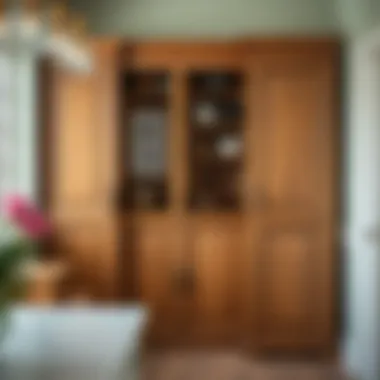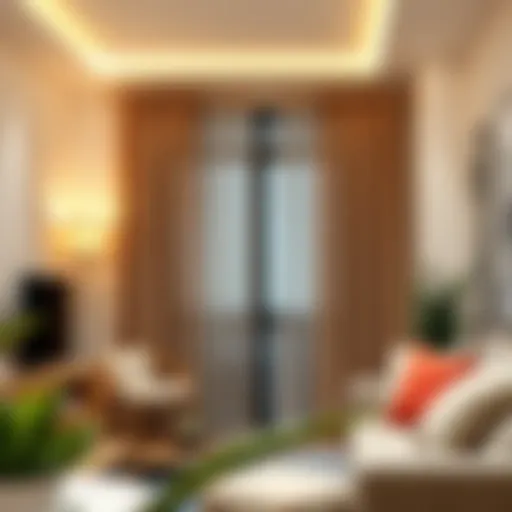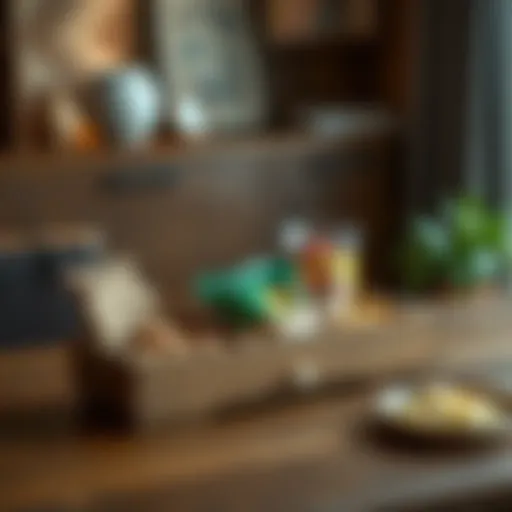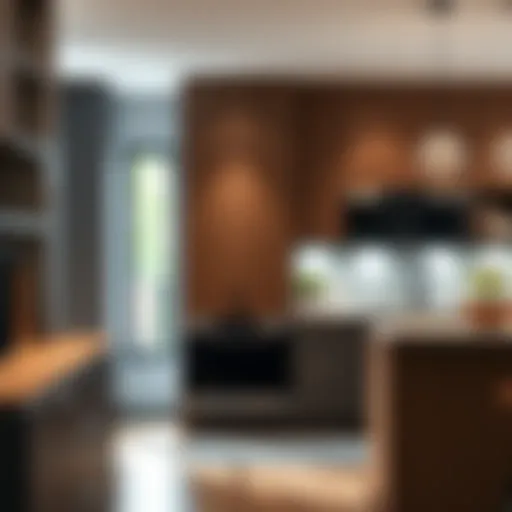Discover the Charm of Wooden Kitchen Pantry Cabinets


Intro
The kitchen serves as the heart of the home, a bustling hub where culinary delights are crafted and family gatherings spring to life. Among its many features, wooden kitchen pantry cabinets stand out—not just for their utility but for their timeless elegance. By infusing warmth and texture, these cabinets elevate any kitchen design, providing both function and beauty.
Today, the trend of utilizing wooden pantry cabinets is on the rise, owing much to their enduring appeal. Homeowners and designers alike are increasingly drawn to these fixtures, recognizing that they do more than store food and kitchenware. They symbolize craftsmanship, sustainability, and a connection to nature.
In this article, we will explore the design trends surrounding wooden kitchen pantry cabinets, guiding you through popular styles, how to incorporate these trends into your space, and practical buying tips. Additionally, we’ll delve into the growing demand for sustainable materials in cabinetry, illustrating how wooden pantry cabinets not only enhance your kitchen's aesthetic but also align with eco-friendly practices.
Prolusion to Wooden Kitchen Pantry Cabinets
The kitchen is often dubbed the heart of the home, and within this bustling space, the pantry cabinet plays a crucial role in both organization and style. Wooden kitchen pantry cabinets, in particular, stand out not just for their functionality but also for their elegance and aesthetic appeal. They can transform the mundane into the extraordinary, adding a warmth and richness that only natural materials can bring. This article aims to provide insights into the multifaceted nature of wooden pantry cabinets, analyzing their advantages, design elements, and maintenance needs.
Defining the Role of a Pantry Cabinet
A pantry cabinet is more than a storage unit; it is an integral component of kitchen design that balances utility and beauty. Traditional kitchens relied heavily on separate pantries, often tucked away for practical reasons. Nowadays, the pantry cabinet is front and center, allowing homeowners to flaunt their stored items stylishly while keeping the appearance of the kitchen neat.
The role of a pantry cabinet is to provide organized storage for various kitchen essentials—be it dry goods, canned items, or even kitchen appliances. With efficient shelving and compartments, these cabinets can aid in maximizing space and ensuring easy access to everything. But beyond mere storage, it serves as a canvas for personalization within the kitchen, reflecting individual tastes and trends.
The Appeal of Wood in Kitchen Design
When it comes to kitchen design, wood holds a timeless allure. It brings a certain charm that man-made materials often struggle to replicate. The warmth of wood can make a kitchen feel inviting, speaking to feelings of comfort and hominess. Different wood species offer varied grains, colors, and textures, allowing for a vast palette of options to suit any homeowner's aesthetic preferences.
From the stately richness of oak to the subtle elegance of maple, wood provides a serious upgrade to kitchen cabinets. Aside from aesthetic values, wood resonates with durability, ensuring that the cabinets can withstand the rigors of daily kitchen use.
In combining aesthetics with functionality, wooden pantry cabinets tell a story through their structure—a narrative of quality, tradition, and sustainable practices. The natural variation in wood not only enhances their beauty but also makes each piece unique, much like the family that uses them.
"Wooden cabinets bring not just utility, but a slice of nature into our homes, creating spaces that resonate with warmth and artistry."
As we explore the various types, styles, and finishes of wooden pantry cabinets, we will see how these features complement kitchen designs and elevate the experience of cooking and gathering in the kitchen.
Types of Wood Used in Pantry Cabinets
Understanding the types of wood utilized in pantry cabinets is crucial for homeowners, designers, and DIY enthusiasts alike. Different wood types offer various benefits and considerations that can influence both the aesthetic appeal and functionality of kitchen spaces. The choice of wood not only affects the looks of the cabinets but also their durability, maintenance needs, and overall impact on the environment. This section will delve into the nuances of hardwoods versus softwoods, followed by a closer look at specific popular wood species, including oak, maple, cherry, and hickory. Each wood type has its strengths and weaknesses, making it essential to choose wisely to achieve a balance between elegance and practicality.
Hardwoods vs. Softwoods
When comparing hardwoods and softwoods, it’s important to note that the distinction is rooted more in botany than it is in quality. Hardwoods are derived from deciduous trees which lose their leaves seasonally, while softwoods come from coniferous trees, which tend to be evergreen.
- Durability: Hardwoods typically showcase greater durability and density, making them often the preferred choice for long-lasting kitchen cabinets. Common hardwoods used include oak, maple, and cherry.
- Cost: Softwoods, like pine and fir, generally come with a lighter price tag, making them appealing for budget-conscious projects. While they can be less durable, they offer a unique charm and easy workability.
In short, your choice between hardwood and softwood will greatly depend on your preferences for aesthetics versus practicality, alongside your overall budget and intended use.
Popular Wood Species for Cabinets
Here we will hone in on four predominant wood species used in pantry cabinets, shedding light on what makes each of them stand out.
Oak
Considered one of the stalwarts of cabinetry, oak is highly prized for its strength and characteristic grain patterns. Oak cabinets tend to age beautifully, developing a patina that adds to their appeal.
Key Characteristics: Oak has a pronounced grain, which can range from straight to wavy. It can provide a warm, rustic feeling to any kitchen.
Benefits: Oak is resistant to scratches and dents, making it ideal for families and high-traffic kitchens.
Drawbacks: The prominent grain may not appeal to everyone, potentially clashing with minimalist designs.
Maple
Maple stands out for its lightweight yet robust nature, making it compatible with various design styles. Its fine, consistent grain allows for a polished and sleek finish, appealing to modern aesthetics.
Key Characteristics: Light in color with subtle grain patterns, maple can easily blend in or stand out based on your finishing choices.
Benefits: It takes stains and paints beautifully and is durable enough to withstand daily wear.
Drawbacks: It can be prone to scratches, which may require more maintenance over time compared to other hardwoods.


Cherry
Cherry is another favorite, often noted for its rich, reddish hue that deepens with age. This wood type embodies luxury and elegance, making it a choice among high-end cabinetry.
Key Characteristics: Smooth grain with a natural luster. Over time, cherry will darken, offering a timeless appearance.
Benefits: It provides warmth and a somewhat traditional feel to the kitchen.
Drawbacks: Cherry can be quite expensive, and its softer nature makes it more susceptible to dents and scratches compared to harder woods.
Hickory
Hickory is known for its incredible toughness and density, making it one of the hardest domestic woods. It offers a striking appearance with its dramatic color variations, ranging from light to dark.
Key Characteristics: The pronounced grain combined with colors allows for a dynamic look.
Benefits: Hickory cabinets can withstand heavy usage, making them ideal for busy kitchens.
Drawbacks: The distinctive appearance may not be suitable for every kitchen style, and it can be challenging to work with due to its toughness.
Choosing the right wood species involves weighing the aesthetic considerations against practical functionality. Each wood type brings its unique charm to wooden kitchen pantry cabinets, enriching the overall design while ensuring it stands the test of time.
Design Styles for Wooden Pantry Cabinets
When it comes to wooden kitchen pantry cabinets, the design style chosen plays a significant role in determining not just the kitchen’s aesthetic but also its functionality. With the right design, a pantry cabinet can seamlessly blend into its surroundings or stand out as a centerpiece, showcasing the elegance of craftsmanship. This section delves into various styles, highlighting their distinct characteristics, benefits, and considerations.
Traditional vs. Modern Aesthetics
Traditional design has a charm that often harkens back to craftsmanship from years gone by. Think of rich mahogany or deep cherry woods, detailed carvings, and brass or antique hardware. These cabinets evoke a sense of warmth and nostalgia, which is perfect for homeowners desiring a cozy, welcoming kitchen atmosphere. On the other hand, modern aesthetics favor simplicity and clean lines. Here, light woods like maple or birch may take the stage, paired with sleek metal accents. Modern pantry cabinets focus on functionality while providing a minimalist vibe, perfect for those who appreciate uncluttered spaces.
When choosing between these aesthetics, consider the overall feel of your home. A traditional pantry might pair beautifully with a farmhouse kitchen, offering a tactile contrast to industrial or modern design elements. Conversely, if your home leans more towards contemporary, then opting for modern pantry cabinets may provide a sense of balance and harmony.
Rustic and Farmhouse Influences
The rustic and farmhouse styles have surged in popularity, reflecting a shift towards natural elements and textures in kitchen design. Wooden pantry cabinets in this category typically boast weathered finishes, visible grain patterns, and a more laid-back appearance. They often feature open shelving or glass fronts showcasing neatly organized dishware, where practicality meets aesthetic appeal.
Embracing this style means harnessing imperfections and celebrating the unique character that wood often provides. Such a design choice not only warms a kitchen but invites a more relaxed atmosphere, invoking feelings of comfort and home. It’s common to see distressed finishes with muted or earthy colors that allow the wood to shine without overpowering the rest of the kitchen's decor. The rustic pantry cabinet can be an ideal companion to modern farmhouse or country-style kitchens.
Contemporary Sleek Designs
In contrast to rustic styles, contemporary design leans heavily on innovation and sleek details. Here, wood is often blended with materials like glass and metal, pushing the boundaries of what pantry cabinetry can look like. The focus is on simplicity, function, and organization. Systems built into these cabinets often feature pull-out trays, hidden drawers, and smart shelving solutions, providing an elegant way to manage storage while emphasizing smooth lines and open spaces.
Choosing contemporary pantry cabinets can transform not only your kitchen but also your cooking experience. The seamless integration of technology, like touch-activated lights or automated shelving, enhances convenience. Additionally, the use of lighter woods and clean finishes allows these cabinets to fit beautifully within both spacious and compact kitchen designs
By thoughtfully selecting the right design style for your wooden pantry cabinets, you set the tone not just for your kitchen’s visual appeal, but also for its practicality. Every style choice has its own flavor, so understanding how each can impact overall kitchen dynamics is crucial for homeowners, designers, and DIY enthusiasts alike.
Functional Features of Pantry Cabinets
When considering wooden kitchen pantry cabinets, functionality should be at the forefront of one’s mind. It's not just about aesthetics; the purpose these cabinets serve can significantly enhance the kitchen experience. Proper storage solutions, accessibility, and customization options are essential elements that can make a pantry cabinet not just another piece of furniture, but a vital component of kitchen organization.
Storage Solutions and Organization
The primary role of a pantry cabinet is to provide ample storage while keeping items organized. Good storage solutions can transform how one uses space. For instance, utilizing adjustable shelving allows homeowners to customize the height of the shelves based on stored items—be it tall cereal boxes or smaller spice jars. Additionally, pull-out drawers can be a game changer. They maximize accessibility, making it easy to reach ingredients at the back without awkward stretching or frustration.
Consider these points when exploring storage solutions:
- Vertical Space Utilization: Full-height pantry cabinets can make the most of vertical space, offering often-overlooked storage potential.
- Baskets and Bins: Incorporating baskets for bulk items can keep things tidy and accessible, while clear bins can help with visibility in darker corners.
- Modular Systems: Many cabinets allow you to add components over time, which means your pantry can grow and evolve with your kitchen needs.
Accessibility and Convenience
Accessibility is another crucial feature that can’t be overlooked. A well-designed pantry cabinet should allow one to find and retrieve items with ease. Features like soft-close doors and integrated lighting can greatly enhance usability. Imagine having the ability to glide open a cabinet quietly at night without disturbing anyone—much less fuss in an already bustling kitchen.
Key aspects of accessibility include:
- Door Style: Bi-fold or slide-out doors can help in tight spaces, ensuring that every inch of the cabinet can be utilized.
- Labeling Systems: Using labels on shelves or bins is a practical way to keep track of pantry inventory. This small step can save time during meal prep, ensuring cookbooks are not the only things gathering dust.
- Ergonomic Design: User-friendly designs can reduce strain when reaching for items, especially in tall cabinets; simple features can ensure everyone in the household can use them comfortably.
Customization and Built-in Options


Customization is a major draw in the world of pantry cabinets. Not every home, or homeowner, is the same, which is why options for tailored features can make a significant difference. Built-in options can elevate functionality while catering to individual needs. Think about how a built-in wine rack or spice drawer could enhance the cooking experience.
Consider these customizable elements:
- Built-in Drawers: Specialized drawers for canisters or cooking utensils can keep things organized while allowing easy access.
- Lighting Considerations: Internal lighting options can be programmed to switch on when cabinet doors are opened, bathing the items in the light of easy view.
- Modular Inserts: Install modular storage solutions like spice racks, pull-out shelving, or even a small area for baking sheets that can neatly fit into your cabinet's layout.
Finishes and Colors for Wooden Pantry Cabinets
When it comes to wooden kitchen pantry cabinets, the choices of finishes and colors play a crucial role in shaping the overall look and functionality. Not only do they enhance the aesthetic appeal, but they also contribute to the longevity of the cabinetry. This section delves into how the right finish can elevate a kitchen space while considering practical aspects, like maintenance and environmental impact.
Stains and Paints: Pros and Cons
Choosing between stains and paints is a decision that hinges on multiple factors. Each offers unique benefits and challenges that can significantly affect the appearance and durability of wooden pantry cabinets.
- Stains: These provide a more natural look, enhancing the grain of the wood. Staining allows homeowners to showcase the beauty of the wood, whether it be a rich oak or a warm cherry. However, the downside is that stains can sometimes fade over time if exposed to direct sunlight or moisture. They may also require more frequent reapplication to maintain that fresh look.
- Paints: On the other hand, paints can completely change the character of a cabinet. With endless color options, paint can provide a contemporary or whimsical touch, depending on the chosen shade. That said, paint may chip over time, and repairs can be more challenging. Therefore, picking a high-quality paint and applying it correctly is vital.
Natural Treatments for Wood Preservation
Preserving wooden pantry cabinets is essential for maintaining their beauty and functionality. Opting for natural treatments can be a sustainable choice, aligning with modern eco-friendly practices. Here’s a look at some popular treatments:
- Mineral Oil: This is an easy-to-apply option that penetrates deeply into the wood. It’s food-safe, making it ideal for kitchen environments. Mineral oil keeps the wood hydrated and helps prevent cracking.
- Beeswax: Known for its protective properties, beeswax forms a barrier against moisture while also enhancing the natural sheen of the wood. This treatment is particularly appealing for those looking to maintain a rustic or farmhouse aesthetic.
- Linseed Oil: Extracted from flax seeds, this oil not only protects but also nourishes the wood. It’s particularly effective for untreated or bare wood, but care is needed since it requires extra drying time and can oxidize, causing a darker finish.
"A well-chosen finish doesn't just protect; it tells a story about your style and values."
Maintaining Wooden Pantry Cabinets
The elegance and functionality of wooden pantry cabinets can be sustained only through proper maintenance. Like a well-tended garden, these cabinets require care and attention to maintain their beauty and practicality over time. For homeowners aiming to prolong the life and appearance of their pantry cabinets, understanding the importance of routine care can make all the difference. The natural characteristics of wood demand a bit more diligence than other materials. After all, maintaining a wooden pantry is akin to nurturing a relationship – it thrives on attention and respect.
Routine Care and Cleaning Tips
To keep your wooden pantry cabinets looking fresh and inviting, developing a cleaning routine is vital. Regular dusting can help prevent particles from accumulating and scratching the surface of the wood. A soft, dry microfiber cloth works wonders for day-to-day dusting. There's no reason to choose something too abrasive, as that can ruin the finish quicker than you can say ‘oops’.
When deeper cleaning is necessary, a gentle solution of warm water and mild soap will suffice. Here's a straightforward way to tackle those cleaning needs:
- Mix Warm Water and Soap: Use a few drops of dish soap in warm water.
- Dampen a Cloth: Soak a soft cloth in the solution, wringing it out until it's damp, not dripping.
- Wipe Down Surfaces: Start at the top of the cabinet and wipe down, following with a clean, damp cloth to remove soap residue.
- Dry Thoroughly: Wipe away any moisture with a dry cloth to prevent warping.
In addition to these techniques, applying a wood conditioner every few months can prolong the life of the finish. This simple act can help restore some luster as well. Just be careful not to overdo it; a careful hand goes a long way when dealing with wooden surfaces.
Addressing Wear and Tear
The inevitable wear and tear on wooden pantry cabinets can often feel like a source of frustration. However, with proactive measures, many common issues can be resolved without too much hassle. Wood can develop scratches, dents, or even fading over time due to sunlight or excessive heat. Addressing these issues is more manageable than many might think.
For minor scratches, a simple trick involves using a walnut or a similar brown crayon to fill in the space, blending it carefully to match the wood grain. If you encounter more extensive damage, there are three approaches to consider:
- Sanding and Refinishing: Lightly sand the area with fine-grit sandpaper before applying a matching stain or finish.
- Coving or Touch-Up Markers: For scratches or dings, touch-up markers designed for wood are available in many shades.
- Professional Help: When things get tricky, don’t hesitate to call in professionals who can match and restore finishes effectively.
"An ounce of prevention is worth a pound of cure." Understanding proper maintenance now can save headaches later on.
Ultimately, nurturing your wooden pantry cabinets through routine care and addressing issues as they arise will ensure your investment remains beautiful and aligns with your kitchen's function for many years to come.
Sustainable Practices in Cabinetry
In today’s world, the emphasis on sustainable practices in cabinetry speaks volumes. As society becomes more conscious of environmental issues, the shift towards eco-friendly solutions in home design has never been more vital. Wooden kitchen pantry cabinets, in particular, embody this consciousness, marrying the beauty of natural materials with careful sourcing and responsible manufacturing techniques.
The move toward sustainability is not just a fleeting trend; it’s a necessary response to environmental challenges. By integrating sustainable practices in cabinetry, homeowners, designers, and retailers alike contribute to a healthier planet, preserve natural resources, and support ethical labor practices. Opting for sustainable cabinetry can lead to benefits such as reduced carbon footprints, enhanced indoor air quality, and long-lasting beauty that carries minimal environmental impact.


Sourcing Responsibly
When considering cabinetry, the journey begins with how the wood is sourced. Responsible sourcing avoids deforestation and promotes conservation efforts. Many choose to look for woods certified by organizations like the Forest Stewardship Council (FSC), which ensures that the materials used come from forests managed sustainably.
- Local Sourcing: By choosing local wood, homeowners can reduce transportation emissions. Plus, local providers often have a better understanding of sustainable practices and the ecosystem’s needs.
- Reclaimed Wood: This option breathes life into old materials, giving them a new purpose while diverting waste from landfills. Each piece carries history, allowing for unique aesthetics.
- Bamboo: Technically a grass, bamboo grows rapidly and can be harvested without killing the plant. It’s durable and offers an eye-catching alternative for cabinetry.
Choosing responsibly sourced materials reflects a commitment to ethical practices, contributing positively to both community and environment.
Eco-friendly Finishing Options
Once the wood is sourced, the next consideration is how it's finished. The right finishing products can dramatically impact the sustainability of wooden cabinetry. Here are some eco-friendly options that respect both wood's beauty and the environment:
- Natural Oils and Waxes: These finishes consist of materials like linseed oil and beeswax. They protect the wood while allowing it to breathe, minimizing volatile organic compound (VOC) emissions that can affect indoor air quality. Additionally, they enhance the wood's natural grain, adding depth to the cabinets.
- Low-VOC Paints and Stains: Traditional paints and stains often release harmful chemicals into the air. Opting for low-VOC alternatives can minimize health risks for families while providing a range of aesthetic choices that do not compromise on quality.
- Water-Based Finishes: These are becoming increasingly popular due to their minimal odor and eco-friendliness. They dry quickly and are easy to clean up, reducing the environmental impact usually associated with solvent-based products.
By choosing eco-friendly finishing options, homeowners and designers can ensure that their beautiful wooden pantry cabinets contribute to a sustainable future, keeping both style and responsibility in perfect harmony.
For further reading on sustainability in cabinetry, consider resources from the FSC, EPA, and educational websites like Wikipedia for an in-depth understanding of eco-friendly practices.
Comparative Analysis of Cabinet Brands
When it comes to wooden kitchen pantry cabinets, choosing the right brand can feel like a daunting task. There are numerous factors that influence the decision-making process, and understanding the nuances of different cabinet brands is crucial. A comparative analysis enables homeowners, designers, and retailers to make informed choices that blend style, functionality, and sustainability. Brands each have their own unique characteristics, which can differ widely in terms of quality, price, design styles, and environmental considerations. This section delves into what to look for when evaluating these factors, helping readers identify the right fit for their kitchen.
Evaluating Quality and Price
Quality tends to be the top concern for many when selecting wooden pantry cabinets. Not all cabinets are created equal. Factors such as materials used, construction methods, and finishes can determine whether a cabinet withstands the test of time or falls apart after a few years.
When examining quality, consider the following points:
- Construction Method: Look for cabinets that are solid wood or plywood rather than particle board.
- Joinery Techniques: Dovetail joints and mortise-and-tenon joints are signs of craftsmanship and durability.
- Finishing Quality: A good finish will not only enhance the appearance but also protect the wood from moisture and scratches.
Price is another aspect that often goes hand-in-hand with quality. It is tempting to opt for the cheapest option available; however, this may result in hidden costs down the line, such as maintenance and replacements. Below is a brief outline to consider:
- Budget: Set a realistic budget ahead of time; high-quality cabinets may come with a higher price tag, but the investment often pays off in longevity.
- Comparative Shopping: Compare similar styles across different brands to gauge average prices. This can reveal which brands offer better value.
- Warranty and Support: Reputable brands usually provide good warranties as an assurance of their product quality. A warranty is also a sign that the company stands behind their craftsmanship.
"Investing in quality cabinets is akin to investing in your home’s foundation; it pays dividends in functionality and aesthetics over time."
Manufacturer Reputation and Sustainability
Brand reputation can often serve as a powerful indicator of quality and reliability. A manufacturer with a good reputation typically has a history of customer satisfaction and superior product offerings. Here are a few considerations regarding reputation:
- Consumer Reviews: Exploring customer feedback on websites, forums, and social media platforms can provide insight into performance and common issues related to a brand.
- Awards and Certifications: Look out for any industry recognition or certifications, which can often signify quality standards or commitment to sustainability.
Sustainability is increasingly becoming a deciding factor in cabinet purchasing decisions. Many homeowners now seek products that not only meet aesthetic and functional needs but are also environmentally friendly. Prioritizing manufacturers who adopt sustainable practices can enhance the overall value of your kitchen design. Key points to consider include:
- Source of Materials: Choose brands that use sustainably-sourced wood. Forest Stewardship Council (FSC) certified wood is an excellent option for environmentally conscious homeowners.
- Manufacturing Practices: Support companies that utilize eco-friendly processes, which may produce fewer emissions and waste.
- Longevity and Design: Sustainable cabinets should also embrace timeless design, promoting longevity and reducing the need for replacements.
In summary, a thorough comparative analysis of cabinet brands helps in navigating the labyrinth of choices available in the market. High-quality, sustainably-made cabinets can greatly enhance the aesthetics and functionality of a kitchen space, ensuring that your investment stands the test of time.
Finale
The discussion around wooden pantry cabinets is not merely about aesthetics; it’s an exploration of functionality married to design. A well-crafted pantry cabinet brings a blend of style and utility to any kitchen, enhancing both the visual appeal and the organizational structure. By understanding the various design options and functional features, homeowners and designers can make informed choices tailored to their specific needs.
The Future of Wooden Pantry Cabinets
The future of wooden pantry cabinets seems promising, characterized by a shift towards sustainability and innovative designs. As eco-consciousness grows, the demand for sustainably sourced materials will likely increase. Manufacturers are now focusing on renewable wood sources, implementing practices that align with environmental stewardship. Moreover, advances in technology could lead to smarter cabinetry solutions, integrating features like automated shelving or energy-efficient lighting. This evolution will make pantry cabinets not just storage units but also a seamless part of a technologically advanced kitchen landscape.
Integrating Style with Functionality
Achieving a balance between style and functionality is essential in kitchen design, and wooden pantry cabinets provide an excellent canvas for this integration. The choice of wood, finish, and hardware can significantly influence the cabinet's overall look while retaining its practical benefits. For instance, lighter woods like maple can brighten a space, making it feel more open and airy, while darker shades like walnut offer a sense of warmth and richness. Customization options allow for specific needs, ensuring that every inch of the cabinet is used effectively, be it pull-out shelves for easy access or built-in dividers for organized storage.
"Wooden pantry cabinets not only enhance the kitchen's beauty but also elevate its functionality to new heights."















